Cow’s Milk Allergy (CMA) sometimes called Cow’s Milk Protein Allergy (CMPA) is a common food allergy among infants and young children that is caused by an allergic reaction to proteins in cow’s milk. It can produce a range of reactions including hives, vomiting, diarrhea, and anaphylaxis that can be potentially life-threatening. Effective management involves completely eliminating cow’s milk and dairy products from the diet and ensuring adequate nutrition is received through alternative sources. This may require the use of specialised formulas or dietary supplements. It is also important to educate patients and their families about the potential for cross-contamination, hidden sources of milk in foods, and how to read allergen labelling. Cow’s milk allergy management takes an individualised approach that considers the patient’s age, medical history, symptoms, and severity of allergy to avoid complications and ensure optimal health outcomes.
How to manage mild-to-moderate Cow’s Milk Allergy
- Breastmilk is the best source of nutrition1,2
- Breastmilk contains all of the nutrition an infant needs.1,2 Importantly, breastmilk contains lactose, probiotics, and prebiotics that help stimulate the gut microbiome and immune system.2
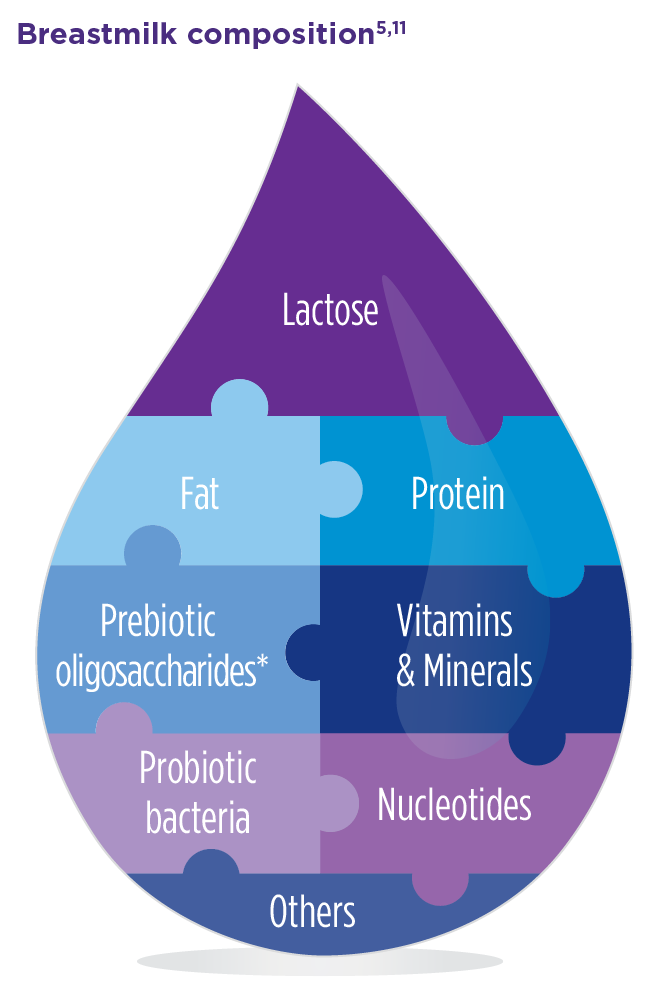
For illustrative purposes only. These pictorial representations are not drawn to scale and represent solid components only, not quantity.
Aptamil® AllerPro SYNEO™ contains more of the components of breastmilk compared to other formula suitable for the management of mild-to-moderate cow’s milk allergy as recommended by ASCIA.7
* Prebiotic oligosaccharides: In breastmilk = HMOs with >200 different structures; 11 In Aptamil® AllerPro SYNEO™ = scGOS and lcFOS in a 9:1 ratio. scGOS/lcFOS to mimic diversity, quantity and functionality of HMOs in breast milk.
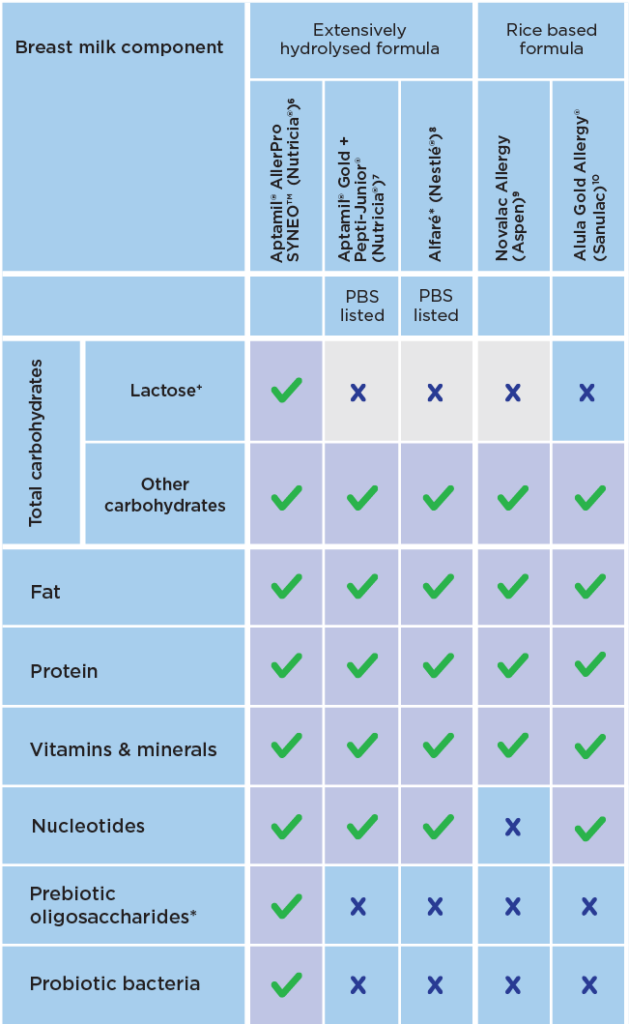
This table represents solid components only, not quantity. Greyed out boxes = low lactose (≤ 0.3 g/100 mL formula)12</br />† Formula with lactose: Aptamil® AllerPro SYNEO™ 2.9 g/100mL; Formula with low lactose (≤0.3 g/100 mL): Aptamil® Gold + Pepti-Junior® <0.1 g/100mL, Alfaré <0.01 g/100mL, Novalac Allergy <0.00135 g/100mL; Formula with no detectable lactose: Alula Gold Allergy.6–10,12
This information is correct as of 10 February 2023. Information sourced from products’ list of ingredients. Some of the ingredients above are not mandated by the ANZ Food Standards Code for Infant Formula Products, so the comparison is not exhaustive. Each product is different and should be assessed separately against the individual needs of each patient.
For Healthcare Professional use only – not for distribution to the general public.
Aptamil® AllerPro SYNEO™ for the management of cow’s milk allergy, contains ingredients that are inspired by breastmilk
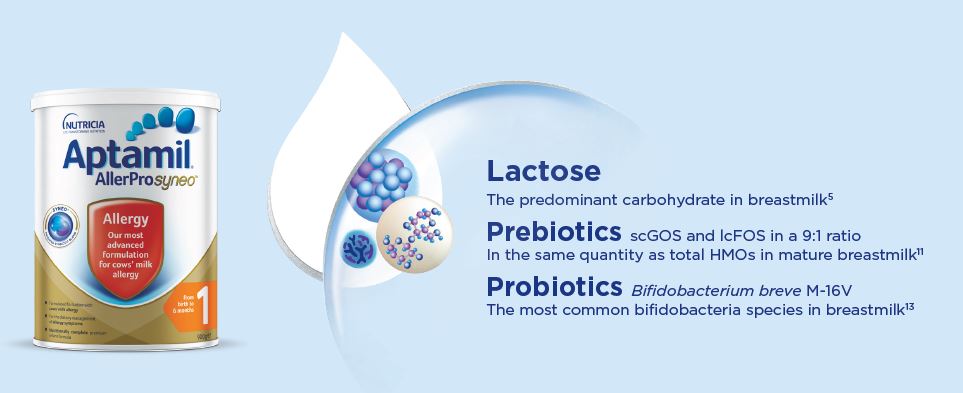
| Lactose has key benefits in the management of CMA and should not be unncessarily avoided3,14,15 |
|---|
| Main carbohydrate in breastmilk5 |
| Safe for consumption by infants with mild-to-moderate CMA13 |
| Increases palatability14 |
| May increase the absorption of calcium and zinc14 |
| May increase the growth of beneficial gut bacteria3 |
| May help to support a healthy immune system to prevent and treat allergic disease3 |
| Benefits of synbiotics for infants with CMA Synbiotics = Probiotics + Prebiotics |
|---|
| Supports infants with CMA, who often have an altered gut microbiota15,16 and are more susceptible to infections17-19 |
| Helps to rebalance the gut microbiota to be more similar to healthy breastfed infants†20 |
Mild to moderate cow’s milk allergy management guide
Aptamil AllerPro Syneo is supported by more product specific clinical evidence than any other formula for the management of mild-to-moderate CMA in Australia and New Zealand.
Access hereRelated Products
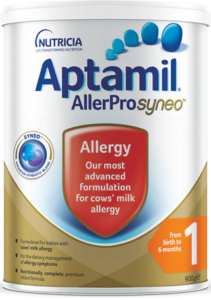
Aptamil® AllerPro Syneo™ 1 (0-6 months)
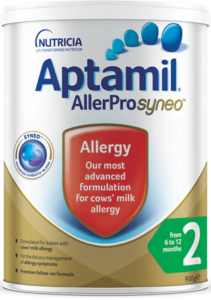
Aptamil® AllerPro Syneo™ 2 (6-12 months)
Inside the tin: A comprehensive guide to infant formula for CMA
Understanding the differences between infant formulas can seem complicated. Read now or download Inside the Tin as we compare and explain types of formula to help guide choice for parents of infants with cow’s milk allergy.
Meet our Careline experts

- Meyer R et al. Allergy. 2020;75:14–32.
- Martin R et al. Benef Microbes. 2010;1(4):367–82.
- Francavilla R et al. Pediatr Allergy Immunol. 2012;23(5):420–7.
- ASCIA. Guide for milk substitutes in cow’s milk allergy. 2023. Link to guide. Accessed Mar 2023.
- Ballard O and Morrow AL. Pediatr Clin North Am. 2013;60:49–74.
- Nutricia. Aptamil® AllerPro SYNEO™ 1. 2023. Link to page Accessed Mar 2023.
- Nutricia. Aptamil® Gold + Pepti-Junior®. 2023. Link to page. Accessed Feb 2023.
- Nestlé Health Science. Alfare®. 2023. Link to page. Accessed Feb 2023.
- NovaNutrition. Novalac Allergy. Link to page. Accessed Feb 2023.
- Sanulac Nutritionals. Alula Gold Allergy. Link to page. Accessed Mar 2023.
- Kunz C et al. Annu Rev Nutr. 2000;20:699–722.
- Soto A et al. J Pediatr Gastroenterol Nutr. 2014;59:78–88.
- Giampietro et al. Pediatr Allergy Immunol. 2001;12:83–6.
- Maslin K et al. Pediatr Allergy Immunol. 2018;29(8):857–62.
- Canani RB et al. ISME J. 2016;10(3):742–50.
- Thompson-Chagoyan OC et al. Pediatr Allergy Immunol. 2010;21(2 pt 2):e394–400.
- Woicka-Kolejwa K et al. Postepy Dermatol Alergol. 2016;33(2):109–13.
- Fiocchi A et al. Nutrients. 2021;13(11):3795.
- Sorensen K et al. Immun Inflamm Dis.2022;10(3):e572.
- Van der Aa et al. Clin Exp Allergy. 2010;40:795–804.
- Van der Aa et al. Allergy. 2011;66:170–7.
BREASTMILK IS BEST FOR BABIES: Professional advice should be followed before using
an infant formula. Partial bottle feeding could negatively affect breastfeeding. Good maternal
nutrition is important for breastfeeding and reversing a decision not to breastfeed may be difficult.
Infant formula should be used as directed. Improper use of infant formula may affect the health of the baby. Social and financial implications should be considered.
